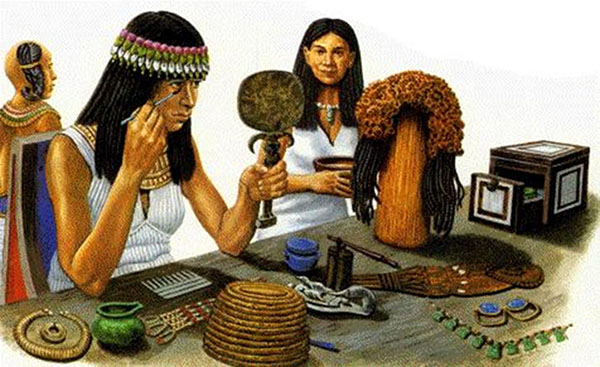Previously, we looked at the sexual behavior within the family unit. Continuing the series, we will examine sexuality within artwork and beauty rituals.
The next aspect of Ancient Egyptian sexuality refers to iconography and beauty. During the pre-dynastic times, the motifs painted in the walls of tombs as well as toiletry items include depicting women in a sexual and sensual manner. Most of these depictions include nudity, grooming, and application of cosmetics and wigs. It is possible to blame this obsession with female beauty on men, since only men were aloud to be scribes and painters.
Men as Attractive Beings
Men were also depicted as being physically attractive in iconography. The bodies of men were adorned with jewelry and sensuous clothing. The ideal man was not to be daunted by labor but still maintained a shapely physique. Aggressive and warlike behavior was reserved for royal citizens only, but was still revered as attractive and appropriate.
Contrary to popular belief, men were a “big” part of Egyptian sexuality. In reference to this, men were often depicted with extra large genitalia especially in the Greco-Roman times. Men were also portrayed as being open with feelings and often wrote love letters and poems to women. This could relate to the fact that men needed to woe women in order to gain and keep them as their companion. Remember from Part I of this series that men often took wives to improve their social status and create bonds with neighboring groups. Obviously keeping a woman happy enough to stay with him, meant a man had to go the extra mile.
Erotic Artwork
Before Playboy, the Ancient Egyptians had their own erotic artwork. The Turin papyrus is one of the most famous, or infamous, depictions of sexual activity during the time of the Ancient Egyptians. This “masterpiece” consists of a series of illustrations including various sexual positions and activities and men with overly exaggerated genitalia. It is also interpreted from Egyptian ostraca, or pottery, that females were involved in a number of professions related to sexuality. Some of these professions include the following: musicians, dancers, entertainers, and adolescent serving girls.
Many of the rooms that contain sexual themes are located in the central part of the house where eating, sleeping, and other domestic duties occur. This could signify that the Egyptians made time to enjoy festivities. Artifacts recovered at Deir el Medina depict Bes, the male deity associated with sexuality, fertility, music and magic as one of the central figures in the house. Our Western-Judeo-Christian assumption is that of partying or lewd sexual behavior. However, his presence most likely represented a “good luck charm” for the fertility of the family.
The Mighty Cow
Ancient Egyptians often make references to cows. Cows drawn with udders usually represent maternity, nurturing, and birth. Goddesses in the pantheon are often anthropomorphic versions of the depiction of the goddess with horns or as a cow. For example, Isis, Hathor, and Nut, are often depicted in this manner. There is also obvious presence of over accentuated cow genitalia, both male and female. This could imply complimentary opposites of male and female as well as the sacred coupling and connectivity through a sexual union.
Cosmetics
Normally we view cosmetics as a means of masking our true identities whether it is for ritualistic behavior, a pop star, or every day use. To the Ancient Egyptians, physical appearance was very important in daily life as well as in the afterlife. Men and women shaved every part of their bodies. Some of the cosmetics that the Egyptians used were eye and face paints, perfumed oils, and ointments. They cleansed their faces and often used a mixture of vegetable oil and lime. Aside from their bodies, they were also concerned with sanitation in the home. This included cleansing, decoration, and incense.
Some of this information is known because of iconography and paintings. However there has also been much learned through grave goods. Many tombs include makeup, palettes, jewelry, clothing, and oils. The Egyptians thought that they could use these products in the afterlife. Jewelry for example was a marker of one’s status in life and in the afterlife. Many times special products were made in order to mix ingredients for makeup. These included the makeup palettes that were ornately decorated and bowls for mixing various fragrances, which were renowned throughout the world, as well as eyeliner. It is noticeable that the Egyptians saw the need to accentuate their eyes more than other parts of their faces and bodies.
Clothing and Sexual Interest
Clothing was not normally worn until the child reached puberty. This could possibly be equated to the fact that this is the time when it was most common for people to become sexually interested in each other. Women often wore white linen and servant girls normally wore bright, multicolored fabrics. It is often that scholars record how Egyptians have labeled women as the aggressor in sexuality due to their dress in the iconography; Cleopatra being the most famous example. She used sex as a weapon to get what she wanted labeling her “The Woman Who Gapes Wide for Ten Thousand Men”.
References:
- David. R. 1998. Handbook to life in Ancient Egypt. Oxford: University Press.
- Hassan, Fekri A. and Smith, Shelley J. 2002. Soul birds and heavenly cows: transforming genger in Predynastic Egypt. In: Nelson, Sarah Milledge and Rosen-Ayalon, Myriam, editors. In pursuit of gender: worldwide archaeological approaches. Walnut Creek: Altamira Press. p 43-65.
- Hornblower, G. D. 1943. The Egyptian fertility rite: postscript. Man 43: 26-34.
- Meskell, Lynn. 1999. Archaeologies of social life: age, sex, class et cetera in ancient Egypt. Massachusetts: Blackwell Publishers.
- Pinch, Geraldine. 1982. Offerings to Hathor. Folklore 93(2): 138-150.








